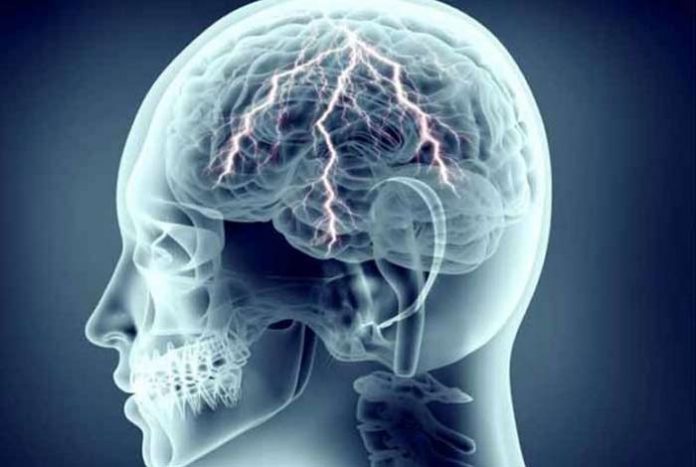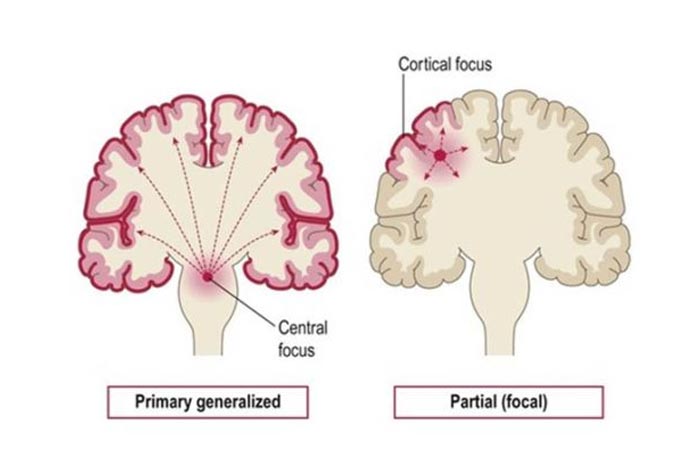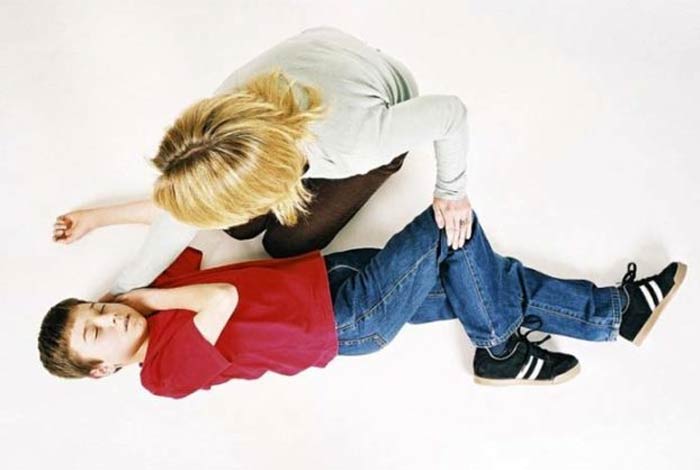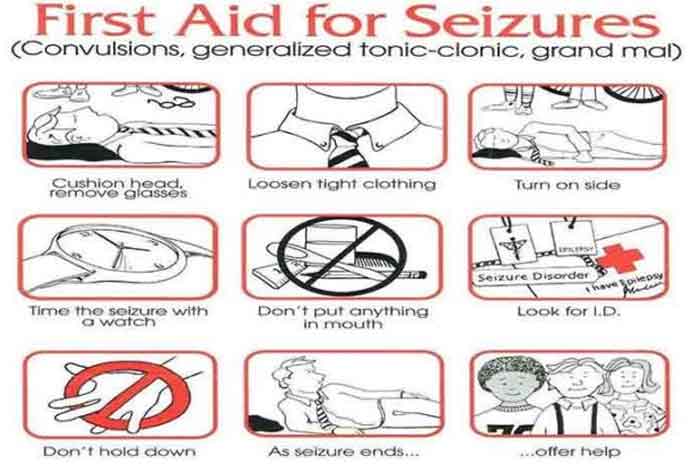
Seizures are temporary loss of control, often but not always accompanied by signs like trembling movements of body, unconsciousness, or both. Most people consider seizure and epilepsy as same entities. However, it must be noted that seizures are not the same as epilepsy. Seizure is a single event or episode. Having two or more seizures, or a tendency of recurrence of seizure, is referred to as epilepsy.
Basically, the brain changes taking place in epilepsy, can cause a seizure episode. Such seizures are known as epileptic seizures and are the most common type of seizures. Epileptic seizure occurs due to sudden, abnormal electrical activities in the brain. When the electrical discharges become excessive in a group of brain cells, it leads to an epileptic seizure episode.
As per WHO statistics, about 10% of people worldwide develop one seizure episode in their lifetime. However, about 50 million people worldwide develop epilepsy, making it one of the most common neurological disorders worldwide. As per the estimate, 2.4 million people worldwide are diagnosed with epilepsy every year. [1]
Other than epilepsy, several other factors can also trigger a seizure episode. These seizures are known as non-epileptic seizures. These have similar presentation as seen in epileptic seizure. But, these are not caused by alteration in brain. Such seizures are usually associated with mental health problems. However, a person can exhibit both epileptic and non-epileptic seizure at the same time.
Seizures can produce a wide range of symptoms. In some cases, seizure may cause jerky muscle movements and loss of consciousness, while in others it may simply cause a brief lapse of attention or a staring spell. The uncontrolled abnormal shaky movements of the body with a loss of control, is referred to as convulsions, which is seen in severe cases of seizures. Thus, seizure can produce dramatic noticeable symptoms, or no symptoms at all.
Seizure has a myriad of inflicting factors and causes, from head injuries, stroke , certain medicines for brain tumor, meningitis, insomnia and even high fever. In many cases, the cause of seizure is unknown.
Most seizures last for few seconds to few minutes. However, if a seizure episode lasts for more than 5 minutes or if the patient does not gain consciousness in between the episodes, it is a medical emergency and needs prompt medical treatment.
Seizures increase the risk of injury and accidents. It can also create medical challenges in pregnant women. Some seizures can be indicative of an underlying medical disorder. It may also have psychological implications. Extremely lengthy seizures can progress to death. Hence, it is important to seek treatment. However, seizures can be managed through medications.
Types of Seizures

Depending on the site of brain, where the seizure activity begins, there are various types of seizures. As per the Centers for Disease Control and Prevention, the classification of seizures is as follows.
1. Focal Seizures
When the abnormal activity begins in one area of the brain, it is referred to as focal seizure. It is also known as partial seizure. These seizures are further classified into several other types.
A. Simple focal seizures: These affect a small part of the brain. They basically change the perception of one’s senses to the real world. They cause twitching, or a change in sensation, such as a strange smell or taste. A patient may experience sweating and nausea but is not likely to become unconscious.
B. Complex focal seizures: This type of seizures can make a person confused or dazed. It affects the part of the brain that controls emotions and memory. The person may not be able to respond to directions or questions for up to a few minutes.
C. Secondary generalized seizures: When focal seizure begins in one small part of the brain, but then spreads to both sides of the brain, it is referred to as secondary generalized seizure. So, such patients initially develop focal seizure, which then progresses to become generalized.
2. Generalized Seizures
When the abnormal activity begins involving both sides of the brain, it is known as generalized seizure. They are primarily classified into the following types.
A. Absence seizures: These are also known as petit mal seizures. They cause staring into a blank space for few seconds or rapid blinking.
B. Tonic clonic seizures: These are also known as grand mal seizures. They can produce distressing features, rendering a person tired after the episode. These features are as follows.
- Losing consciousness
- Crying out
- Developing muscle spasms and jerks
- Falling to the ground
C. Clonic seizures: These are marked by rhythmic or repeated jerky movements of muscles. They usually affect neck, arms and face.
D. Tonic seizures: These cause stiffening of muscles. They usually affect muscles in legs, arms, back and may cause a person to fall to ground.
E. Atonic seizures: This variant is characterized by a loss of muscle control, making the patient collapse or fall down suddenly. Hence, atonic seizures are also known as drop seizures.
F. Myoclonic seizures: These seizures cause sudden brief twitches or jerks of legs and arms.
Symptoms of Seizures

The symptoms of seizures may vary from mild to severe, based on the type of seizure. A person can develop features of both focal and generalized seizures at the same time, or one can happen after another. The symptoms last for few seconds to 15 minutes.
Various symptoms seen before, during and after a seizure episode are described below.
Before the seizure
Some symptoms appear 15 to 20 minutes before a seizure episode and are known as aura symptoms. These are listed below.
- A sudden anxiety or fearful feeling
- A sick feeling in the stomach
- Dizziness
- Vision changes
- Jerky movements of legs or arms, causing one to drop things
- An out of body sensation
- Headache
During the seizure
- During a seizure episode, a patient experiences following symptoms.
- Loss of consciousness, followed by confusion
- Experiencing muscle spasms, which are uncontrollable
- Frothing or drooling at mouth
- Falling
- Developing a strange taste in mouth
- Clenching teeth
- Tongue biting
- Rapid, sudden eye movements
- Making strange noises, like grunting
- Loss of bladder or bowel control
- Developing sudden mood changes
- Emotional or cognitive symptoms, like deja vu, fear, anxiety
- A staring spell
- Temporary confusion
After the seizure
Patient may feel some discomfort, following a seizure episode. These post-seizure symptoms are as follows.
- No memory of seizure episode
- Tiredness and confusion
- Throbbing headache
- Severe weakness in a leg, arm or hand
- Difficulty speaking
- Temporary vision loss or other sensory loss
Risk Factors of Seizures

Although it may be difficult to locate the cause of seizure in some cases, there are certain factors that can trigger a seizure episode. These are as follows.
1. Lack of sleep
Research has shown that patients with seizure episode, usually suffer from sleep disorders, with insomnia being the most common sleep disorder. [2]
2. Stress
Hippocampus, an area of brain, is responsive to stress and is concerned with inflicting a seizure episode. As per a research study, when a person is stressed, certain stress mediators are released, which act on the receptors of hippocampus, causing a seizure episode. [3]
3. Alcohol abuse and withdrawal
As per research, alcoholism or a regular consumption of alcohol raises the brain threshold to seizures. So, when a person quits alcohol, the risk of developing seizure episode increases. [4]
4. Drug abuse
Intoxication with recreational and illegal drugs, like cocaine, amphetamine, phencyclidine and heroin, increases the risk of developing seizure episode. [5]
5. Genetics
People with a sibling or a parent with seizure or epilepsy, are at a higher risk of developing a seizure episode.
6. Other factors
There are certain other factors which have been known to trigger a seizure episode. These are as follows.
- Intense emotions
- Heavy exercise
- Flashing lights
- Loud music
- Menstrual periods
- Fever
Do I Have Seizures?

A misconception prevails among majority of population is that seizures canMeta Description
Seizures are temporary loss of control, mostly linked with epilepsy. Various types of seizures cause many symptoms, like staring spell, falling, etc. It is caused by stress, insomnia, alcoholism, drug abuse, stroke, etc. Treatment includes anti-seizure drugs, ketogenic diet, yoga, acupuncture, etc. always be recognized due to their dramatic signs. But, the fact is that seizures can sometimes be as silent as just staring into a blank space for few minutes or a momentary loss of attention.
So, if you have recently experienced such symptoms, you most likely had seizure. Jerky muscle movement with loss of control is another symptom suggestive of a seizure episode. If you have a family history of seizure or epilepsy, you have a very high chance of developing seizure.
Also, if you are feeling dizzy or sick in your stomach or have developed a sudden fear or anxiety, you may develop seizure anytime as these may be the warning symptoms of a seizure episode. A headache or changes in vision, are other alerting signs one must not ignore.
If you are an alcoholic and have recently quit alcohol, you must stay alert for another 48 hours, as some cases of seizure has been seen in such people. If you are a drug abuser, you lie in the high-risk category of developing seizure. If you have been too stressed or sleep-deprived lately, you may develop seizure.
Causes of Seizures

The wide range of causes of seizures, can give rise to three variants of seizures. These variants, along with their causative factors have been listed below.
1. Epileptic Seizures
As already stated, these are the most common type of seizures and are caused by epilepsy. Our brain consists of millions of brain cells (medically known as neurons). These brain cells generate, send and receive electrical impulses. These impulses are the path of communication of the brain cells, which regulate several bodily functions. Any disruption in this communication pathway can lead to abnormal behavior and movements, resulting in a seizure episode. These brain alterations are mostly seen in patients with epilepsy. Also, epilepsy may be an inherited condition. Hence, genetic factor can be a cause of such seizures.
2. Non-epileptic seizures
As already mentioned, not all seizure patients have epilepsy. Other causes of seizures are as follows.
- High fever
- Brain infection, such as meningitis
- A brain injury during childbirth
- A brain defect at birth
- High blood pressure
- Kidney failure
- Low blood sodium (medically known as hyponatremia), which is commonly seen in people undergoing diuretic therapy
- Certain medications, like antidepressants, pain-killers, smoking cessation therapies, etc.
- Stroke
- Head trauma, which may cause bleeding in the brain
- Brain tumor
- Alcoholism and drug abuse
Prevention of Seizures

Avoidance of trigger factors can prevent the onset of a seizure episodes. These preventive measures are as follows.
1. Get enough sleep
As already stated, insomnia or sleep deprivation can trigger a seizure. Hence, adequate sleep can prevent seizure.
2. Refrain from alcohol, smoking and recreational drug
Alcoholism and drug abuse are some of the most significant factors, increasing the risk of developing seizures. Also, smoking cessation therapy can cause seizure. Hence, refrain from alcohol consumption, smoking cigarettes and drug abuse.
3. Manage your stress levels
Stress is one of the factors, which can put a person at a higher risk of developing seizure. Hence, it is important to manage the stress levels. This can be accomplished through yoga, meditation and any form of exercise.
4. Avoid heavy exercise
Moderate exercise should be followed, with intervals of rest and adequate hydration. Heavy strenuous exercise can increase your risk of developing seizure.
Diagnosis and Tests for Seizures

When a patient presents to a clinic, with a complain of a seizure episode, doctor will evaluate the patient through following methods.
1. Medical history and events before seizure
Doctor may take a thorough history, regarding patient’s medical conditions, medications being taken by the patient and the events which preceded seizure episode. This helps the doctor in recognizing the factor that could have triggered a seizure episode.
2. A neurological exam
In order to recognize problem with nervous system, doctor can perform a neurological exam to examine patient’s behavior, mental function and motor abilities.
3. Blood test
A blood sample may be taken to check for low blood sugar, electrolyte imbalances and signs of infection.
4. Lumbar punctur
: If the doctor suspects a brain infection, your doctor may perform a lumbar puncture. In this procedure, a needle is inserted in the spine to extract a small amount of fluid present around the brain (medically known as cerebrospinal fluid or CSF). The fluid sample is then sent to laboratory for examination.
5. An electroencephalogram (EEG)
Since a seizure episode could indicate an abnormal activity in the brain, doctor assesses the brain activity with the help of EEG. Electrodes are placed on the patient’s scalp. These electrodes record the electrical activity of the brain as wavy lines. Based on the events that lead on to a seizure episode, doctor may perform EEG in the clinic itself or at home with the aid of an ambulatory device. Doctor may also choose to record several reports of EEG, by hospitalization of patient. EEG helps the doctor in recognizing the cause of seizure and predicting whether seizure is likely to occur again or not.
6. Computerized Tomography (CT)
A CT scan is a special X-ray test, which is done to reveal images of brain. This helps the doctor in locating a tumor, cyst or a brain bleed, that could have inflicted a seizure episode.
7. Magnetic Resonance Imaging (MRI)
This test uses magnetic and radio waves to produce clear detailed images of brain. This helps the doctor in recognizing lesion or abnormalities of brain, which may have caused seizure.
8. Positron Emission Tomography (PET)
A PET scan involves injecting a low dose of radioactive material in the patient’s vein to visualize active areas of brain, along with abnormalities.
9. Single Photon Emission Computed Tomography (SPECT)
A SPECT scan is a nuclear imaging test, which involves injecting a radioactive material in patient’s vein, followed by use of a special camera to produce detailed 3-d images of brain. This helps in assessing the brain functioning and blood flow during a seizure.
Treatment of Seizures

The goal of treatment in these patients is a seizure-free life with minimum side-effects of therapy. Identifying the underlying cause is the key to prevent future episodes of seizures. Since seizure is an isolated incident, doctor may not start treatment until another episode occurs.
However, there are various treatment modalities for epileptic seizures. These are described below.
1. Medications
Anti-epileptic or anti-seizure medications form the mainstay of treatment of seizure. These drugs prevent the recurrence of seizure episode. Anti-seizure medications include carbamazepine, gabapentin, lamotrigine, diazepam, clonazepam, valproic acid, etc. It must be noted that every medicine may not be suitable for every patient. Hence, finding the right medicine is important to effectively treat seizure. However, if a patient is not responding to any anti-seizure medication, other treatment options must be considered.
2. Surgery
If a brain abnormality has been located, and patient is not responding to medication, the brain anomaly can be surgically removed to prevent the seizure episodes in future. Surgery is particularly useful if seizures always originate in the same area of the brain.
3. Vagus nerve stimulation
This method is used as an add-on treatment to drug therapy, but it lowers the dose of medication required. A device is inserted beneath the skin in the left upper chest region. This device is connected to the left vagus nerve. This device stimulates the vagus nerve to send signals to the brain, which further prevents the onset of seizures. [6]
4. Responsive neurostimulation
Patients not getting better with medications may require this therapy. In this procedure, a neurostimulator is placed on brain’s surface or inside the brain tissue. Whenever a brain area evokes a seizure activity, this stimulator detects the concerned area and blocks the seizure activity, hence preventing seizure episode.
5. Deep brain stimulation
If a patient is not responding to medications, and surgery cannot be performed, deep brain stimulation may benefit the patient. In this therapy, electrodes are placed inside the brain. These electrodes are attached to a neurostimulator placed beneath the skin in upper chest area. The electrodes produce electrical impulses to maintain a normal brain activity. The neurostimulator acts like a heart pacemaker and mediated the impulse generation by the electrodes.
6. Ketogenic diet
Ketogenic diet has been used for the treatment of seizure since 1920. It is usually indicated in patients not responding to anti-seizure medications. A ketogenic diet typically consists of high fat and low carbohydrate. Unlike other diets, a ketogenic diet prompts the body to utilize fat to produce ketones and eventually energy (a process, medically known as ketosis). Research has shown that ketogenic diet can significantly reduce the frequency and severity of seizure episode by several mechanisms, including making neurons more resilient, altering brain pH, inhibitory effect on ion channels of brain and increased production of an inhibitory brain chemical, called gamma-Aminobutyric acid (GABA). [7]
Care of Seizure Patients

Although there is no way to terminate a seizure episode without medical help, but there are certain measures which must be taken by people around the patient. These are as follows.
During the Seizure episode
You must follow these points to take utmost care of the patient experiencing a seizure episode.
- Clear the area around the patient to prevent possible injury.
- Do not try to restrain the patient.
- Roll over the patient onto one side.
- Place a cushion under patient’s head.
- Loosen tight neck wear, if any.
- Do not put anything in the patient’s mouth.
- As soon as you notice the patient having a seizure, time the seizure and observe the patient closely until the medical personnel arrive. This may help the doctor in identifying the exact cause and type of seizure.
Call Emergency Medical Service
It is important to call emergency medical service, if any of the following applies.
- Seizure lasts for more than five minutes
- Patient does not wake up after seizure episode.
- Patient experiences repeated seizure episodes.
- Patient is pregnant.
- Patient never had a seizure before.
After a Seizure Episode
Once a patient regains consciousness after a seizure episode, bear the following points in mind.
- Check the patient for any injury.
- If you were unable to roll over the patient during the seizure episode, do it after the episode ends.
- If the patient is having trouble in breathing, clear the patient’s mouth of any vomit or saliva. Also, loosen the tight clothing around waist and neck.
- Stay with the patient until he/she is fully awake and oriented.
- Do not offer any eatable or beverage until you are sure that the patient is completely awake.
Seizure can be emotionally and physically distressful for anyone. Hence, support from family, friends and peers can be of great help. Learn about their condition, keep a list of their medications and talk to the patient about his/her well-being. Care for people facing the brunt of this condition.
OTC Drugs for Seizures
There are no over-the-counter anti-seizure drugs available due to the potential side-effects associated with these drugs. However, patients on anti-seizure medications may develop certain vitamin deficiencies. Hence, vitamin supplements of vitamin B6, E, D, biotin and folic acid, may be available over-the-counter, which can benefit these patients.
Self-Management Methods Available for Seizures

Besides medical therapy, there are numerous ways to manage seizures on your own. These methods are described below.
1. Take your medications as per doctor’s instructions
Anti-seizure medications carry some serious side-effects. Hence, it is important to stick to doctor’s prescription. Do not alter the dose of medications without consulting your doctor.
2. Wear a medical alert bracelet
Get yourself a bracelet with your medical condition inscribed on it. This will help the emergency medical personnel to help you in the event of another seizure episode.
3. Healthy lifestyle
A healthy diet, enriched with vitamins and minerals, along with regular exercise can help you deal with the condition. This also includes managing your stress levels through yoga, meditation, etc.
4. Take care during biking and playing sports
Wear a helmet while riding a bike or participating in sports, as seizure episode during such activities can cause serious injury.
5. Take care near water
You must take special care in the vicinity of water, such as while swimming or while riding a boat. A seizure episode when near water can cause accidental drowning. Hence, have company during these activities.
6. Talk to your doctor about change in medicatio
If you had a seizure episode and you suspect some medication to be the inflicting cause, talk to your doctor about the alternate option.
7. Talk to your doctor if planning a pregnancy
If you are planning pregnancy, seek medical advice as some of the anti-seizure medications can harm the growing baby.
8. Teach your family and friends about your condition
At the event of a seizure episode, your family and friends must take essential steps to prevent complications. Hence, teach them all the first-aid steps to be taken during a seizure episode.
9. Support group
Seizure has many psychological implications. Hence, finding and talking to people dealing with the same condition, can ease up your journey. So, find support groups for seizures.
Natural Ways to Cure Seizures

Medical intervention is of paramount importance in treating seizures. However, certain natural ways have emerged to complement the beneficial effects of conventional therapy. These are enlisted below.
1. Herbal Remedies
Various herbs have been discovered, which can benefit seizure patients. Most of these herbs belong to Indian Ayurveda, Japanese Kampo and Chinese origin. These include mistletoe, hydro cotyle, groundsel, lily of the valley, burning bush, etc. However, the role of these herbs in seizure is not well-validated and require more research to be considered absolutely safe.
2. Yoga and Exercise
The release of endorphins in brain, caused by exercise can elevate mood and relieve stress. The mind-body connection achieved through yoga can also aid in managing stress levels. These also help in managing blood sugar levels and regulating sleep-wake cycle, both of which are necessary to prevent and combat seizures.
3. Meditation
Meditation has been long known to reduce stress and anxiety. It can be practiced anytime of the day and imparts a mindfulness, thus relieving stress and anxiety.
4. Acupuncture
This alternative medicine approach, finds it use in treating several conditions, like heart conditions, brain disorders, etc. By boosting circulation and regulating hormonal balance, acupuncture can help in managing seizures.
5. Dietary habits
Having a healthy diet, enriched with vitamin B6, vitamin E, folic acid and omega-3 fatty acids, can help in managing seizures. These include seafood, legumes, lean meat, egg, nuts, fish, etc. Also, refrain from sugary food and beverages, alcohol and refined food items. A ketogenic diet, with more fat and less carbohydrate, should be adopted to prevent seizures.
Health Tip by Experts
Seizure, is not just a health condition, but a crippling sensation with a worried family and lots of medications. Stay strong, keep fighting and do not let your illness take over your happiness.





